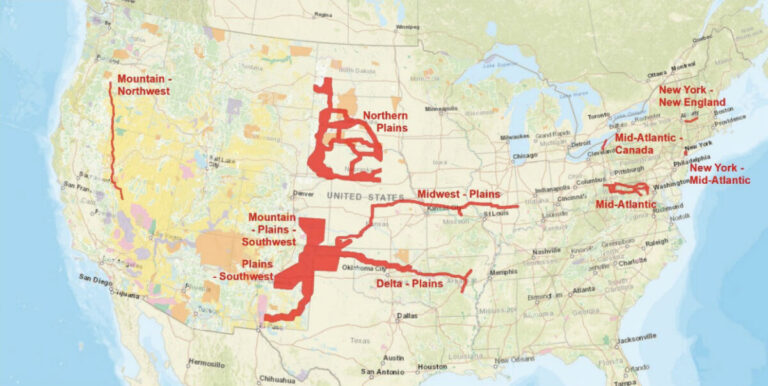Eight of the 10 transmission corridors proposed by the U.S. Department of Energy (DoE) could facilitate transmission between grid regions. One would expand transmission within the PJM network area of the Mid-Atlantic, and one would expand transmission in the Northern Plains.
The American DoE does have that suggested 10 National Interest Electric Transmission Corridors (NIETC), as shown in the image above, and is accepting public comment on the potential NietCs.
The DoE searched earlier input from the industry for the first phase of the UITC designation process.
A NietC designation, once final, “unlocks” federal funding and allows tools to incentivize construction of transmission projects “to alleviate consumer harm,” the DoE said. Such damage could arise from transmission capacity limitations or congestion “now or in the future”, and could manifest itself in lower reliability or higher costs.
For example, when transmission is congested, some of the cheaper renewable energy must be curtailed rather than delivered to customers.
In terms of transmission financing, a UITC designation could unlock public-private partnerships through the Bipartisan Infrastructure Law’s $2.5 billion Transmission Facilitation Program, as well as direct lending through the U.S. Inflation Reduction Act’s $2 billion Transmission Facility Financing Program .
A NietC designation also allows the U.S. Federal Energy Regulatory Commission to issue permits for the construction of transmission lines within the NietC if the local authority does not have the authority to place the line, or has not responded to an application for more than a year, or have rejected an application.
The DoE has presented in a report its preliminary findings on transmission capacity limitations or congestion within each of the ten geographic areas it has proposed for NietCs. Streamlined interconnection of generators is one of the expected benefits of transmission development resulting from the UITC designation, the DoE said.
One of the DoE’s ten proposed NietCs would expand transmission within the Mid-Atlantic PJM network region, allowing the PJM network operator to maintain and improve reliability, reduce consumer costs, and meet future growth in the generation and demand.
Another proposed NietC in the Northern Plains would specifically help Native American tribes develop energy resources, stabilize energy costs and boost local economic development.
These two proposed NietCs reflect a finding in the DoEs Research into national transmission needs that 54,500 GW miles of transmission within the region must be added for a clean electricity grid in “the most likely future of the energy sector.”
Eight of the ten proposed NietCs would facilitate transmission between grid regions, reflecting a needs assessment finding that interregional transmission capacities to transport electricity between regions would need to increase by almost 125 GW in the most likely future of the energy sector.
Here are the eight proposed NietCs and the regions they would connect:
- A New York-New England NietC would increase transmission capacity between the New York and New England grid regions.
- A New York-Mid-Atlantic NietC would increase transmission capacity between the New York and PJM grid regions and facilitate offshore wind interconnection.
- A Mid-Atlantic-Canada NietC would connect the PJM grid region to a Canadian grid region.
- A Midwest-Plains NietC would facilitate interregional transmission between the PJM, MISO, and SPP network regions.
- A Delta-Plains NietC would improve transmission between the SPP and MISO network regions and potentially connect the eastern and western interconnections.
- A Plains-Southwest NietC would facilitate transmission between the WestConnect, SPP, MISO, and PJM network regions, and possibly the CAISO network region.
- A Mountain-Plains-Southwest NietC would connect the eastern and western interconnections and potentially facilitate transmission between the WestConnect and SPP network regions.
- A Mountain-Northwest NietC would facilitate inter-regional transmission between the CAISO and NorthernGrid regions.
The DoE will a webinar on the current phase of the UITC designation process on May 16.
The DoE previously said it expects to reopen the UITC designation process following each publication of its triennial National Transmission Needs Study or as determined by the Secretary of Energy.
This content is copyrighted and may not be reused. If you would like to collaborate with us and reuse some of our content, please contact: editors@pv-magazine.com.


